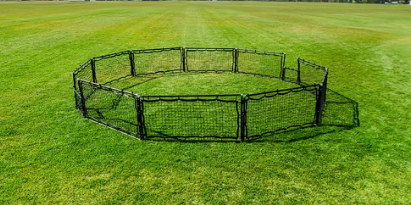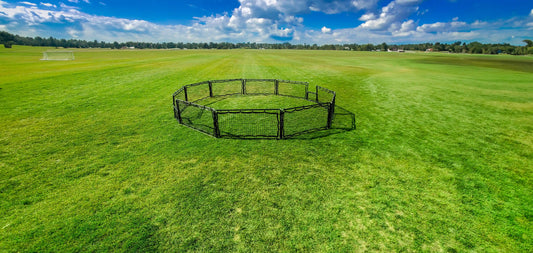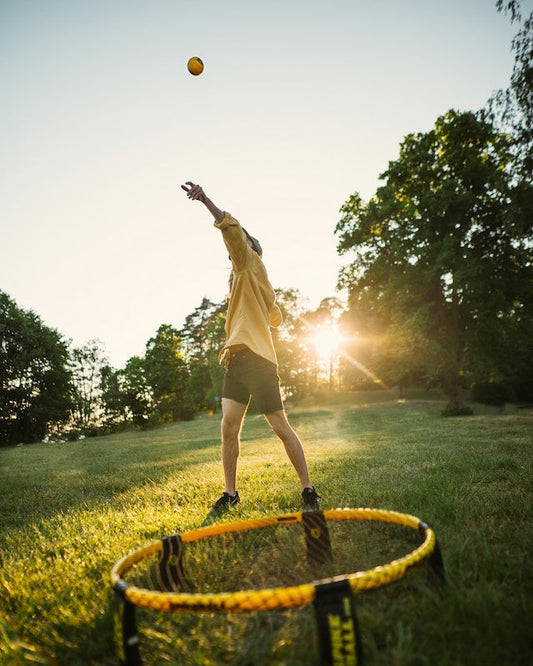Bad weather days can be the worst, especially if it means your students can’t get their wiggles out during outdoor recess. And too often, indoor recess games consist of board games or computer time - neither of which incorporate physical activity.
So…..
If you're looking for a way to add a movement break or switch up your indoor recess games, you've come to the right spot! Below, we've listed the top 9 active indoor recess games to get kids wiggles out - all original and all safely rambunctious options for indoor recess.
Note: Equipment alternatives are listed at the bottom of the article.
1. Rolling Basketball Marble Maze
Equipment you'll need:
2 hula hoops, 1 basketball, a speaker (or some way to play music), 1 chair per kid.
How to set up:
Have each kid stand in a random part of the room (teachers can help assign spots) OR move their desks away from one another. Place a hula hoop in one corner close to a student and one in the direct opposite corner. Place the basketball in one of the hula hoops.
How to play:
The goal of the game is to pass the ball (by rolling it) from one hula hoop to the other - but every student must touch the ball, each student can only touch the ball once, each student must not move their feet at all, and when passing the ball, they can't pass to a student next to them. They have from the time the song starts to when it ends to get the ball to the other hoop. If a kid touches the ball twice, the ball leaves the ground, or the ball accidentally rolls too far for a student to reach it, they start over. If this is too easy, have them pass it there and back.
If you have a crowded classroom, use a soft foam ball or balloon and have kids gently toss the ball to each other - all other rules still apply.
2. Color Corner Basket Toss

Equipment you'll need:
4 baskets or buckets, about a foot in diameter.
80-120 colored ping pong balls
How to set up:
Put baskets in a square shape an equal distance apart (as far as your kids can throw the ping pong balls)
In each basket, place 1-2 colors of ping pong balls.
Split the class into 4 teams, assign each team one basket.
How to play:
Standing from behind their baskets, teams throw their ping pong balls into any of the other teams baskets. Older kids must make it in directly, if playing with little ones, allow them to bounce it in. After all the balls have been thrown, teams collect their ping pong balls that didn’t make it into a basket. The team that collected the least amount of balls off the ground wins the round.
3. The Moving Caterpillar Race

Equipment you'll need:
1 ball per team (balls of equal size)
How to set up:
Split the class up into 2-4 teams of equal size. Give each team a ball.
How to play:
Students sit crisscross applesauce to form each team into a line (knees touching or almost touching). The lines start at the end of the classroom. Each student closest to the wall starts with the ball. They must gently pass the ball to the next child and then run to the far end of the line to advance the “caterpillar”. The goal is to get to the other side of the room and back in this “relay” of sorts before the other team(s). If a student drops a ball, they simply retrieve it and sit back in the spot they were before, and can then pass the ball onto the next player.
4. Simon Says Hot Potato
Equipment you'll need:
One ball, A timer
How to play:
Plays exactly the same regular hot potato - except while passing the “hot potato”. The game starts with players walking in a circle, facing inwards. At the command of “simon”, players must hop on one leg, two legs, gallop, skip, do a spin before passing the hot potato etc. When the timer is up, the player holding the ball is eliminated and so on.
5. Lava Crossing Boulder Relay
Equipment you'll need:
5 paper plates per team, 1 soccer ball per team (or equivalent)
How to set up:
Split kids into 2-3 teams, depending on class size. Mark on one end of the classroom where the “lava” starts and on the opposite side where the “lava” ends.
How to play:
Teams must start on one side and safely cross by laying the plates down and stepping on them. Only 4 players can cross at a time, they must leave one plate (boulder) to move forward so that players don’t step in the lava. If a player loses their balance and steps in the lava, they must go back to the start - the people crossing can decide if they want to go back to retrieve them or continue forward and come back later. Each time 4 players cross successfully, one child will have to cross back and get 3 new players, until all players have crossed successfully. To add complexity to the game, give each team a soccer ball that they must also get across (just once) - they must hold it and not throw it.
6. Alphabet Line-Up Race

Equipment you'll need:
52 paper plates or sheets of colored construction paper - write the alphabet out twice, one letter per plate. Differentiate the two alphabets by putting a dot of color on the plates so they won’t be mixed up.
How to set up:
Separate the two plate alphabets into two corners of the room - mix them up and spread them out a bit. Split the class into two teams.
How to play:
The goal of the game is to find the alphabet (in order) and run to the other side of the classroom and line them up (in order). The first team to find and line up their alphabets completely wins. Mix the teams up and play again. Only one player can run a plate over at a time, but the whole team can look for the next letter. A different player has to run the plate over every time. To mix things up, players must hop or skip over to place the plate into the alphabet line.
7. The Rabbits and the Gardener
Equipment you'll need:
1 ping pong ball (to act as a carrot), 1 flashlight
How to set up:
Give one student the flash light (the gardener) and one student the ping pong ball. Have all other students (the rabbits) scatter throughout the classroom.
How to play:
The goal is for the rabbits (students) to pass the carrot (ping pong ball) to everyone, without getting caught by the "gardener". Turn the lights off. The “gardener” with the flashlight must alternate between closing their eyes and listening for 7 seconds and opening their eyes for 7 seconds. For the gardener to “catch" the ping pong ball they shine the flashlight on a rabbit they think has the carrot - if that player has the ball, then the gardener wins and a new gardener is chosen. If they guess incorrectly then they close their eyes for 7 more seconds - or, if they choose no one in those 7 seconds, they close their eyes again. If every student manages to hold the ping pong ball, then the rabbits win and a new gardener is chosen. Adjust the time the gardener has their eyes open and closed depending on class size to give the rabbits a fair chance. If little ones (Pre-K) are scared of the dark, keep the lights on and simply have the gardener close their eyes.
8. Jester Juggle Zig Zag Catch
Equipment you'll need:
Small cones (can be made out of colored construction paper), plates, or hacky sacks - something students can balance on their heads as “jester hats”. 1-2 lightweight foam balls that can be easily passed/caught.
How to set up:
Alternate students in 2 lines facing each other - have each student balance a cone on their head. One student (the “jester”) starts with the ball.
How to play:
Students must successfully pass the ball to the student across from them, and then cross sides to the other line, while keeping their cone balanced on their head. Then the new “jester” must pass to the opposite side, and then cross sides, so that at the end of the game, every student has both passed the ball and switched sides. If a student drops the ball or loses their cone, they move to the end of the line, and the game continues. For added fun, split the class up into two teams and have them race against each other OR have students crab walk or grapevine when switching sides. For older students, have two or more balls going at once - start one a little bit after the other.
9. Astronaut Training Camp

Equipment you'll need:
1 basket, 6 ping pong balls, 1 paper airplane, 2 hula hoops, 1 jump rope, 3 blown up balloons, and 6 plastic spoons.
How to set up:
Set up the four stations (outposts) in the four corners of the room (described below), and place a jump rope in the middle of the room (home base). Split the class into 4 teams and assign them each to a starting outpost.
How to play:
The goal of the activity is for each student to complete each station to “graduate” training camp and become an “astronaut”. There are four stations, and to get to the next station, each student must return to the “home base” and jump rope 10 times successfully. Below are the four stations:
Moon landing practice - place the two hula hoops 10 feet apart. Have 2 students take turns holding the first hula hoop as high as they can. Leave the second hula hoop on the ground. Students must stand 5 feet beyond the first hula hoop, and take turns throwing a paper airplane through the first hula hoop and landing it in the second hoop. The station is completed when every student has successfully “landed on the moon”
Fuel Transport - Using only the spoons to touch the “fuel tanks” (balloons), the students must pick up and carry all three balloons at the same time, across the room and back without dropping them. If they drop the balloons, the fuel is lost, and they have to start over.
Asteroid Navigation - Make a simple obstacle course out of chairs, somewhere between 15-20 feet long, with about 3 feet of space between each chair. Students will take turns closing their eyes and navigating through the obstacle course. Only one student will go at a time. The rest of the students will talk to their teammate and tell them which way to turn to navigate the obstacle successfully. The student navigating the obstacle course must NOT touch a single chair or they have “crashed” and must restart. Remind students to go slow and listen to their team so that they don’t trip over a chair.
Moon Rock Toss - Line up a few desks in a row (less for younger kids, more for older kids), minimizing the gap between them as much as possible. Put a basket at the end of the desks. Students must take turns bouncing the ping pong balls across the desk and into the basket. The station is completed after every student gets their ping pong ball into the basket.
In summary, incorporating a variety of indoor recess ideas can transform even the most stubborn weather-bound afternoons into joyful opportunities for movement, laughter, and learning. Whether you're organizing fast-paced games or relaxed social activities, there are options that can suit older students as well as the younger crowd. Indoor activities can be a fun way for any teacher to adapt and ensure students stay engaged and active. From classic gym games to imaginative exercises that challenge both mind and body, there's always a fun activity to brighten any indoor recess. Of course, you can always stick to the rainy day basics - musical chairs, board games, freeze dance, and montessorian unstructured play. But don't shy away from trying new games that fit your unique teaching style and classroom culture. Your students will appreciate the creativity, and you'll be pleased with the positive energy these breaks can generate, indoors or out!
Learning objectives: Social skills, gross motor skills, and fine motor skills.
There are of course dozens of other ways to use your classroom space creatively without turning it into a gymnasium. The hope is that by helping students have fun during indoor recess they will not be as disruptive during class instruction and they will be more connected to the other students. The most important aspect of indoor recess is safety and fun and we are confident the above activities will be a hit for any classroom!
Classroom management tip (for wiggles) with indoor activities in mind: For a math activity, use math manipulatives - counting cubes, base ten blocks, and disc counters. It's a fun way to increase movement for younger kids, without having them leave their desks.
Equipment Alternatives:
Ping Pong Balls: Crumpled pieces of paper
Foam balls (for tossing games): Medium to small sized balloons







